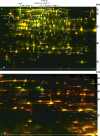Analysis of the Actinobacillus pleuropneumoniae ArcA regulon identifies fumarate reductase as a determinant of virulence
- PMID: 18378638
- PMCID: PMC2423083
- DOI: 10.1128/IAI.01540-07
Analysis of the Actinobacillus pleuropneumoniae ArcA regulon identifies fumarate reductase as a determinant of virulence
Abstract
The ability of the bacterial pathogen Actinobacillus pleuropneumoniae to grow anaerobically allows the bacterium to persist in the lung. The ArcAB two-component system is crucial for metabolic adaptation in response to anaerobic conditions, and we recently showed that an A. pleuropneumoniae arcA mutant had reduced virulence compared to the wild type (F. F. Buettner, A. Maas, and G.-F. Gerlach, Vet. Microbiol. 127:106-115, 2008). In order to understand the attenuated phenotype, we investigated the ArcA regulon of A. pleuropneumoniae by using a combination of transcriptome (microarray) and proteome (two-dimensional difference gel electrophoresis and subsequent mass spectrometry) analyses. We show that ArcA negatively regulates the expression of many genes, including those encoding enzymes which consume intermediates during fumarate synthesis. Simultaneously, the expression of glycerol-3-phosphate dehydrogenase, a component of the respiratory chain serving as a direct reduction equivalent for fumarate reductase, was upregulated. This result, together with the in silico analysis finding that A. pleuropneumoniae has no oxidative branch of the citric acid cycle, led to the hypothesis that fumarate reductase might be crucial for virulence by providing (i) energy via fumarate respiration and (ii) succinate and other essential metabolic intermediates via the reductive branch of the citric acid cycle. To test this hypothesis, an isogenic A. pleuropneumoniae fumarate reductase deletion mutant was constructed and studied by using a pig aerosol infection model. The mutant was shown to be significantly attenuated, thereby strongly supporting a crucial role for fumarate reductase in the pathogenesis of A. pleuropneumoniae infection.
Figures






Similar articles
-
Analysis of the Actinobacillus pleuropneumoniae HlyX (FNR) regulon and identification of iron-regulated protein B as an essential virulence factor.Proteomics. 2009 May;9(9):2383-98. doi: 10.1002/pmic.200800439. Proteomics. 2009. PMID: 19343711
-
An Actinobacillus pleuropneumoniae arcA deletion mutant is attenuated and deficient in biofilm formation.Vet Microbiol. 2008 Feb 5;127(1-2):106-15. doi: 10.1016/j.vetmic.2007.08.005. Epub 2007 Aug 15. Vet Microbiol. 2008. PMID: 17881160
-
Enzymes involved in anaerobic respiration appear to play a role in Actinobacillus pleuropneumoniae virulence.Infect Immun. 2005 Jan;73(1):226-34. doi: 10.1128/IAI.73.1.226-234.2005. Infect Immun. 2005. PMID: 15618158 Free PMC article.
-
Virulence factors of the swine pathogen Actinobacillus pleuropneumoniae.Microbiologia. 1996 Jun;12(2):171-84. Microbiologia. 1996. PMID: 8767702 Review.
-
Actinobacillus pleuropneumoniae surface polysaccharides: their role in diagnosis and immunogenicity.Anim Health Res Rev. 2000 Dec;1(2):73-93. doi: 10.1017/s1466252300000074. Anim Health Res Rev. 2000. PMID: 11708600 Review.
Cited by
-
Comparative Efficacy in Challenge Dose Models of a Toxin Expressing Whole-Cell Vaccine against Eight Serovars of Actinobacillus pleuropneumoniae in Pigs.Animals (Basel). 2022 Nov 23;12(23):3244. doi: 10.3390/ani12233244. Animals (Basel). 2022. PMID: 36496765 Free PMC article.
-
Proteomic and immunoproteomic characterization of a DIVA subunit vaccine against Actinobacillus pleuropneumoniae.Proteome Sci. 2011 Apr 20;9(1):23. doi: 10.1186/1477-5956-9-23. Proteome Sci. 2011. PMID: 21507263 Free PMC article.
-
Global effects of catecholamines on Actinobacillus pleuropneumoniae gene expression.PLoS One. 2012;7(2):e31121. doi: 10.1371/journal.pone.0031121. Epub 2012 Feb 8. PLoS One. 2012. PMID: 22347439 Free PMC article.
-
The Metabolic Adaptation in Response to Nitrate Is Critical for Actinobacillus pleuropneumoniae Growth and Pathogenicity under the Regulation of NarQ/P.Infect Immun. 2022 Sep 15;90(9):e0023922. doi: 10.1128/iai.00239-22. Epub 2022 Aug 8. Infect Immun. 2022. PMID: 35938858 Free PMC article.
-
Actinobacillus pleuropneumoniae genes expression in biofilms cultured under static conditions and in a drip-flow apparatus.BMC Genomics. 2013 May 31;14:364. doi: 10.1186/1471-2164-14-364. BMC Genomics. 2013. PMID: 23725589 Free PMC article.
References
-
- Ashworth, J. M., and H. L. Kornberg. 1966. The anaplerotic fixation of carbon dioxide by Escherichia coli. Proc. R. Soc. Lond. B 165179-188. - PubMed
Publication types
MeSH terms
Substances
Grants and funding
LinkOut - more resources
Full Text Sources

